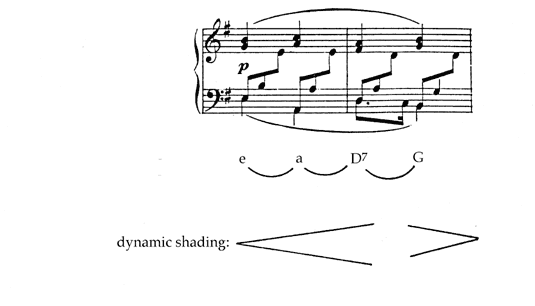
Musical Insights, Vol. 1 (Spring 1997) [Prev] [Next] [MACRO] [Journal Home] [Submissions]
Throughout the chronicled history of music theory research, numerous analytical systems have been devised to assist musicians in the identification and explanation of structural properties in music. Despite the method an analyst may choose to use as a study tool, the goal is usually to acquire information that may not readily be evident in a superficial study of a composition. Once information has been procured through analysis, the intellectual enlightenment gained may be converted to practical applications. One of these appositions is the utilization of analysis information in the development of a performance interpretation.
Performers encounter a deluge of difficulties when attempting to develop an interpretation. Although numerous strategies may be employed to assist in the process of interpretive decision making, often, the development of an interpretation is left to the performer's instinctive talents, or imitation of another's example. Wallace Berry writes in Musical Structure and Performance:
The growing literature on analysis and performance notwithstanding, even the most thoughtful interpreter commonly acts on purely intuitive inference and judgment rarely of articulate substance. This is not to deny that intuitively informed performance is often convincing, as for example when a gifted interpreter, out of long and profound experience, relatively spontaneously finds the "right" tempo or dynamic inflection. But we all know how frequently and how deeply musical realization can suffer from the performer's failure, whether out of inability or impatient denial, to explore in probing analysis those problems of interpretive choice that every artist faces in encounters with challenging works.1
Although many of the practiced analytical methods serve sufficiently to expose information required to develop an appropriate interpretation, the technique known as macro analysis--with its inherent ability to exemplify directional movement toward a goal and identify principal harmonic gestures within a composition--serves as an ideal guide for making interpretive decisions. Through its implementation in the evaluative process, macro analysis can enhance the performers problem-solving capabilities and may be employed to verify the validity of interpretation choices. Its application additionally allows the performer to consider possibilities not readily evident solely through instinct and permits the performer the opportunity for a cohesive organization resulting in an interpretative unification at various levels throughout the structure of the composition. Edward T. Cone explains in Musical Form and Musical Performance:
The composition must proceed inexorably in time; we cannot go back to explain, we must therefore decide what is important and make that as clear as possible. . . . Every valid interpretation thus represents, not an approximation of some ideal, but a choice: which of the relationships implicit in this piece are to be emphasized, to be made explicit?2
Macro-analytical techniques can be particularly useful to the instructor of performance studies. When assigned the task of creating an interpretation, students will often rely on a decision-making process based on schooled imitation. While much can be learned by the pedagogical technique of teacher demonstration/student simulation, this method may not promote the development of self sufficiency in creating an interpretation. The ease with which macro analysis identifies functional harmony and structural cohesiveness can serve as a catalyst for convincing the inexperienced interpreter the necessity for developing a performance plan based on concrete structural evidence. Macro analysis may enable students to develop individualized decision-making skills regardless of the extent of their "traditional" analytical capabilities.
Whether an interpreter is a seasoned professional or untrained novice, the macro analysis system may be engaged to assist in the discovery of primary compositional elements. To illustrate its viability in interpretation studies, two different applications follow to cite evidence of the method's utilitarian benefits. This is not to state that macro analysis is the only feasible technique for assisting in interpretation development or that only two interpretative possibilities exist, but rather, to imbue the formidable gains that can be achieved through its use.
Whether or not a composition includes specific directions for levels of dynamic inflection, performers usually include additional dynamic nuances in the interpretation of a composition. This practice of dynamic shading often finds application within the boundaries of given markings, but also may be observed in situations where no dynamic directions are provided--as in, for example, Early Music.
Dynamic subtleties may be employed in performance interpretations for the purpose of emphasizing fluctuating points of tension and release in a composition. Within the tonal system, harmonic progressions governed by circle-of-fifths relationships establish the various levels of expectation and resolution throughout a composition. Since the identification of circle-of-fifths progressions is inherent to the macro analysis system, its analysis application is useful in developing interpretations of dynamic inflection.
Numerous examples are available from tonal music literature to illustrate the practice of adding dynamic shading to established dynamic-level parameters set forth by the composer. An excerpt from the composition Von Fremden Ländern und Menschen by Robert Schumann is provided to exemplify the manner in which dynamic inflection may assist in emphasizing forward harmonic movement and eventual resolution (example 1).

Macro analysis reveals that within the two measures marked piano, a series of circle-of-fifths progressions initiate forward movement and increasing harmonic tension in anticipation of the G major target chord (e-a-D7-G). This circle series achieves heightened fortification at the arrival of the D major-minor seventh chord due to its dominant function and the inclusion of the leading-tone pitch. Ultimately, the resolution to the target chord allows the progressively augmented tension to subside.
Dynamic shading can serve to accentuate this element of tension and release. To emphasize the harmonic movement toward the target chord, a subtle crescendo may be applied in correlating imitation of the increasing harmonic tension. Following the performance of the dominant harmony, D7, a slight diminuendo can be used to accompany the arrival of the target chord, G, to signal the harmonic resolution. Since the composer has indicated a dynamic level of piano, the interpretive crescendo and diminuendo should be confined within the framework of the given marking.
The process of adding dynamic inflection to a performer's interpretation is not limited exclusively to works in which dynamic level specifications are indicated by the composer; the procedure may also be applied to tonal compositions that lack dynamic markings. The performance of Early Music literature on modern instruments often requires an interpretation that will serve as an appropriate link between the instrumentation originally intended and the modern-day adaptation. Examples of this symbiosis include the performance of harpsichord/clavichord music on the piano and arrangements of Early Music compositions that utilize modern instrumentation. Since repertoire from this period often lacks performance indications, the cultivation of an interpretation requires the consideration of dynamic application.
Creating an interpretation for compositions lacking dynamic markings may be approached in the same manner as the previously presented technique of adding dynamic shading to compositions with fixed markings. Through macro analysis location of circle progressions, primary harmonic events--such as points of tension, resolution, forward movement and prolongation--may be identified and reflected through dynamic interpretive choices. To clarify the manner in which these choices may be made, the Prelude in C major from Bach's Well-Tempered Clavier, Book I, is given with suggested dynamic inflection application based on information revealed through macro analysis (examples 2.a and 2.b).
The opening measures of the Prelude serve to establish the tonic, C major. To allow for dynamic expansion and to ordain kinship with the original instrumentation, a piano dynamic level may be utilized. Following the initial statement of the C major triad, various series of circle progressions serve to emphasize the tonic, but also to initiate temporary travel to related regions, thus creating fluctuating areas of harmonic tension and resolution (measures 1-19). As may be observed in example 2.b, the vacillation between areas of harmonic movement and the return to C major suggests that dynamic inflection may be applied to mimic the harmonic movement: areas of forward movement and increasing tension to be accompanied by a crescendo; resolutions of a circle progression to be signaled with a diminuendo. Additionally, the circle series that first includes a non-diatonic pitch (a-D7-G-C in measures 5-8) is accompanied by a slightly louder dynamic level--mezzo piano instead of piano---to accentuate the temporary tonicization of G major.
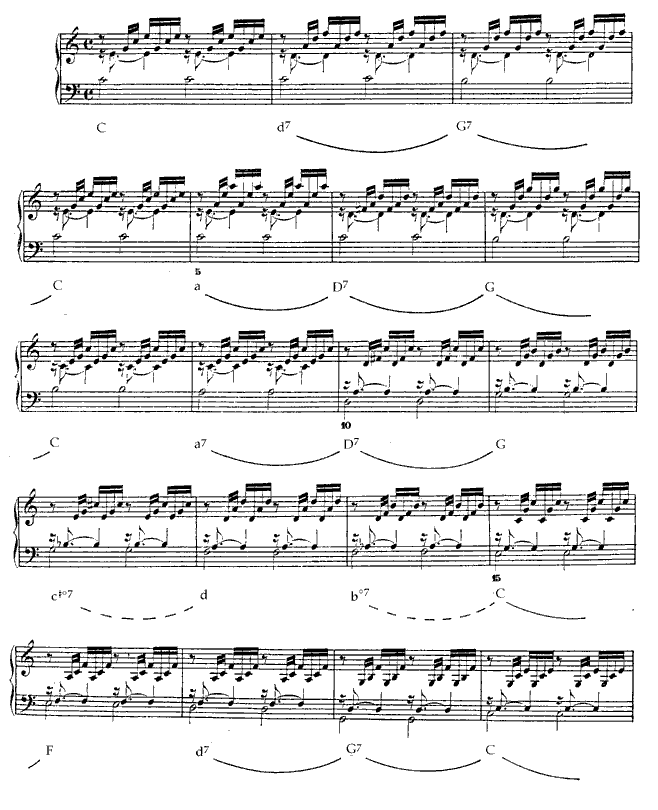
Example 2.a
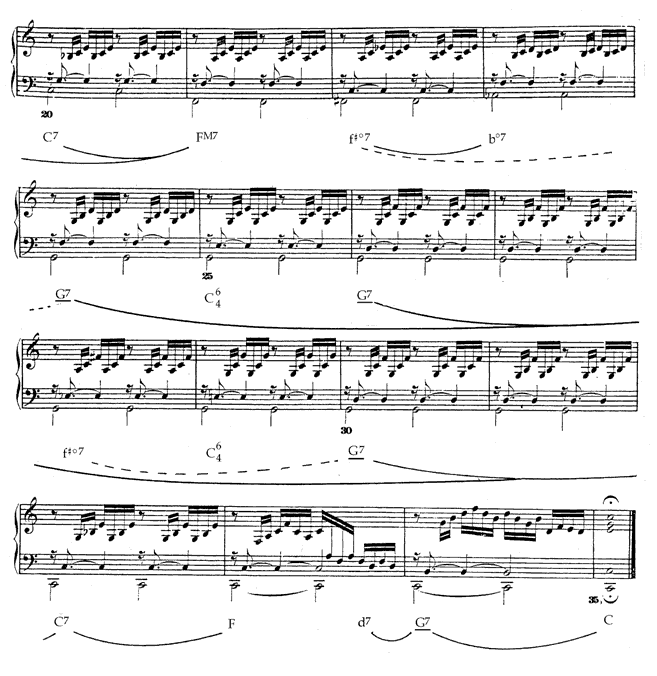
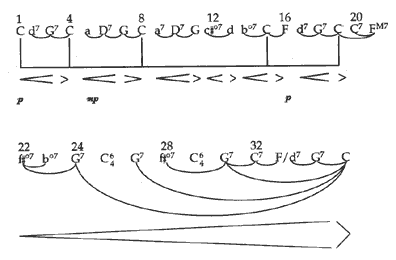
Example 2.a, continued
As previously mentioned, macro analysis reveals not only the chord-by-chord circle progressions within the Prelude, but also the manner in which the tonic is established and reemphasized in measures 1-19 despite points of chromaticism. While analyzing the individual circle progressions provides much information that may be applied to the technique of dynamic shading, the larger perspective of tonal prolongation may be reflected in a performer's interpretation. Macro analysis provides evidence of areas of prolongation as may be corroborated in example 2.b.
Following the C major prolongation in measures 1-19, a short harmonic link leads to an area of dominant prolongation in measures 24-34. The recurring emphasis of the dominant harmony, which is embellished with tonicizations and tonic six-four chords, creates a gradually increasing intensity and heightened expectation for resolution to the tonic, C major. Whereas the tonic prolongation in measures 1-19 allowed for internal dynamic shading within the framework of a piano dynamic level, the dominant prolongation in measures 24-25 may be emphasized with a gradual, long-term crescendo to imitate the increasing expectation for the tonic. Within this overall crescendo, temporary dynamic fluctuations may be employed to affirm internal circle progressions and tonicizations.
Employing macro analysis as an interpretive tool allows performers to identify primary and secondary harmonic levels within a composition, and permits them to illuminate various events through the addition of dynamic inflection. The addition of dynamic nuance is then reflective of structural properties within the composition, highlighting prolongations, forward movement, areas of cumulating tension and points of resolution.
The identification of circle-of-fifths progressions through macro analysis can serve to elucidate large-scale harmonic pillars in tonal music. As proposed earlier, locating principal events within a composition may aid the performer in developing an interpretation that is reflective of structural properties. Once primary circle-of-fifths gestures are located within a tonal work and harmonic function is identified, the performer may then highlight points of importance through various interpretation devices.
Rubato may be used as a tool to articulate significant relationships within a composition. Although historical performance practice considerations must be made when developing an interpretation that includes rubato, its application may be used to stress structural elements of importance. To exemplify this technique for including rubato in an interpretation, an analysis of the primary circle relationships in Chopin's Prelude in E minor is given, with suggestions for the application of rubato (examples 3.a and 3.b).
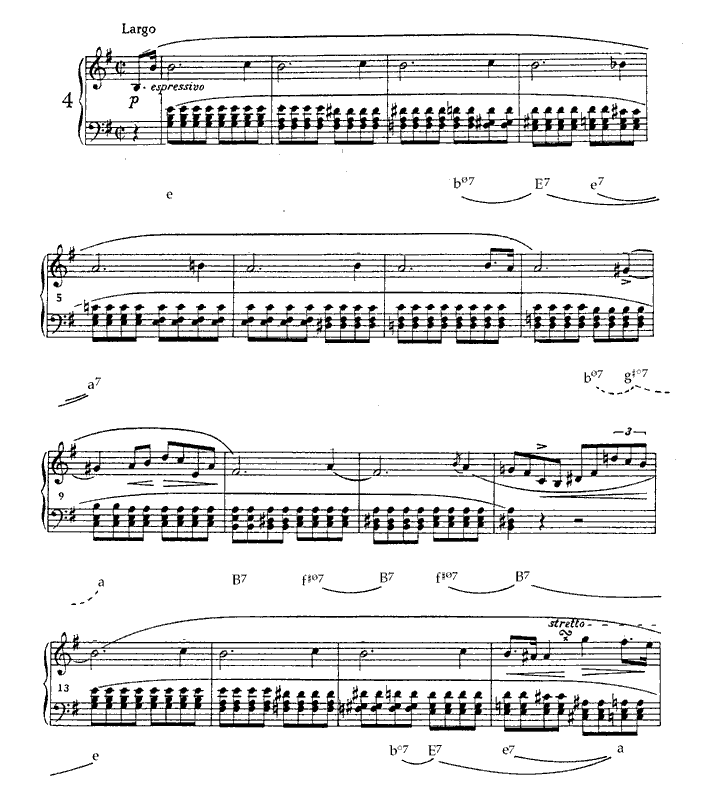
Example 3.a
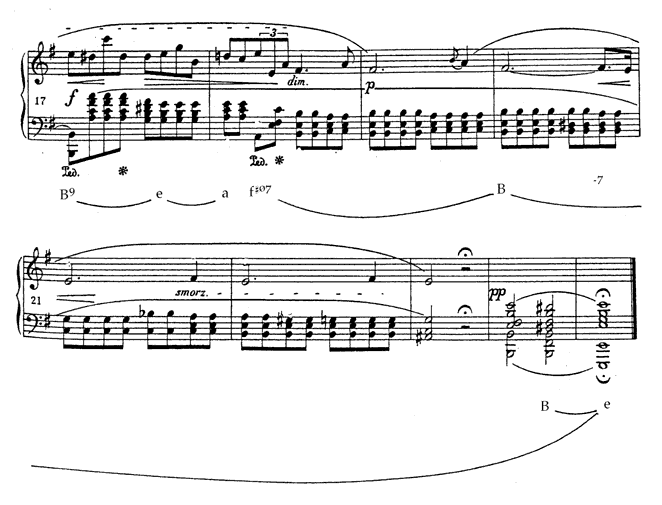
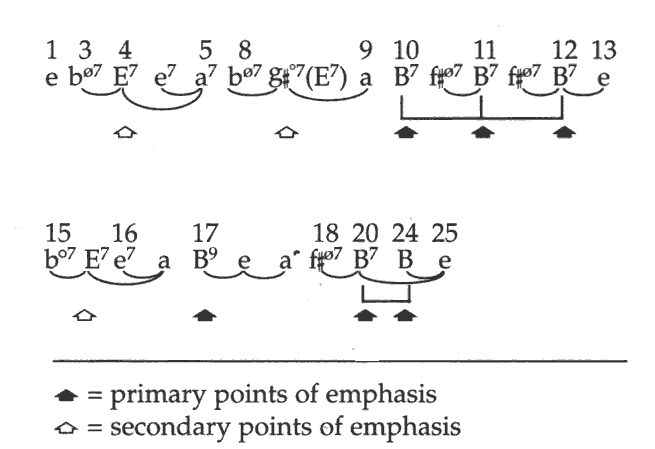
The identification of the principal circle-of-fifths progressions is particularly valuable in the study of this Prelude due to the large number of non-circle linear progressions. In measures 1-10, the tonic, E minor, progresses to the dominant through a series of descending stepwise movements; although these ten measures are infiltrated with numerous chromaticisms, circle progressions may be identified within the context of the linear descent. Interestingly, the two circle series formed around the descending bass line (bø7-E7/e7-a7 in measures 3-5, and bø7-g#o7-a in measures 8-93) correspond with a change in the melodic line. To project the circle-of-fifths chords and signal the impending melodic line change, a slight tenuto may be applied to the first sounding of each of the circle chords (same chord repetitions should not receive the tenuto and should move forward at the original tempo or with a slight accelerando). Chords given this agogic accent application may be approached in a tentative manner to provide even further emphasis. By deliberately choosing the circle chords for durational emphasis, rubato is limited to points of importance, thus avoiding excessive use of the performance device, and thereby highlighting the tonal gestures within a linear setting.
The technique of applying agogic accents to chords of intrinsic importance may be extended to the realm of prolongation. For example, measures 10-12 of the Prelude include a dominant prolongation embellished with an alternating pre-dominant harmony (B7, f#ø7-B7, f#ø7-B7). Each initial sounding of the dominant may be given a tenuto application, with successive returns to the dominant emphasized by lengthier agogic accents. The mounting tension resulting from the dominant prolongation is then further stressed through increasing durational elongations. A second, more extensively embellished dominant prolongation occurs at the end of the composition (measures 20-24) and may be approached in the same manner for rubato application.
Identification of the large-scale circle-of-fifths pillars within the Prelude's harmonic structure serves not only to indicate appropriate spots for agogic accent rubato, but also to distinguish areas that should not be supplemented with durational lengthening. The final section of the Prelude (measures 13-25), is dominated by large-scale circle relationships. As previously suggested, each initial sounding of the circle progression chords may be emphasized with varying degrees of durational accents; the non-circle harmonies that exist between the circle progression pillars, such as those located in measures 21-23, may have their decorative function illustrated by a lack of durational stress. Observance of the given smorzando should be included in the performer's interpretation, but without emphasis of the individual non-circle harmonic changes.
The practice of altering given note values through the use of rubato may be incorporated into an interpretation to expose the fabrication of compositional elements. By reserving the application of rubato for emphasis purposes, a cohesive interpretation may be formulated. Macro analysis provides a serviceable means for differentiating between large- and small-scale landmarks within a composition, thereby assisting the performer in choosing points for rubato application.
Macro analysis may be used to assist performers in making decisions about various approaches to creating an interpretation. The information gained from macro analysis can serve to determine appropriate application of dynamic inflection--whether it be for dynamic shading or adding dynamic markings to works without indications. Macro analysis may be employed to identify large-scale harmonic movement within a composition and assist in the application of rubato. These aforementioned applications, while fulfilling different functions, illuminate important structural points within a tonal composition. As Erwin Stein wrote in Form and Performance:
The performer's paramount concern is to realize the character of the music; it is the purpose for which the music was written. He should not begin with preconceived ideas about moods or emotions to be expressed, but seek the character in the music's formal features. It is the structure of the music, resulting from its melodic, harmonic, rhythmical and dynamic components, that determines form and character at the same time. The character is given by the structure.4
Macro analysis is an ideal vehicle for disclosing the structural information necessary to develop an interpretation. Whether the performer is an experienced or novice interpreter, macro analysis unmasks the necessary information without requiring the labyrinthine procedures of traditional analysis. Once the analytical techniques inherent to the system are mastered, the speed with which the system may be applied, and the ease with which both large- and small-scale information is revealed, makes macro analysis the perfect analytical tool for the performer.
Wallace Berry, Musical Structure and Performance (New Haven: Yale University Press, 1989), 1-2.
Edward T. Cone, Musical Form and Muscial Performance (New York: W. W. Norton and Co. Inc., 1968), 34.
The G#°7 serves as a substitute for E7; the two chords posess similar function and share three pitches in common. (G#, B and D).
Erwin Stein, Form and Performance (New York: Alfred A. Knopf, 1962), 20.